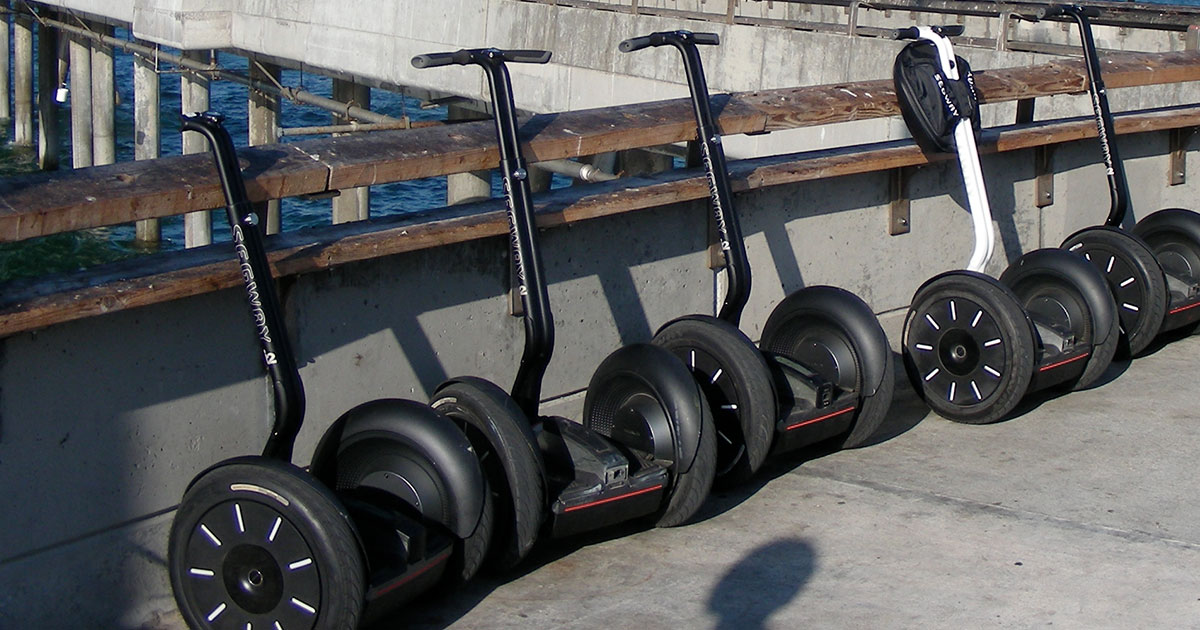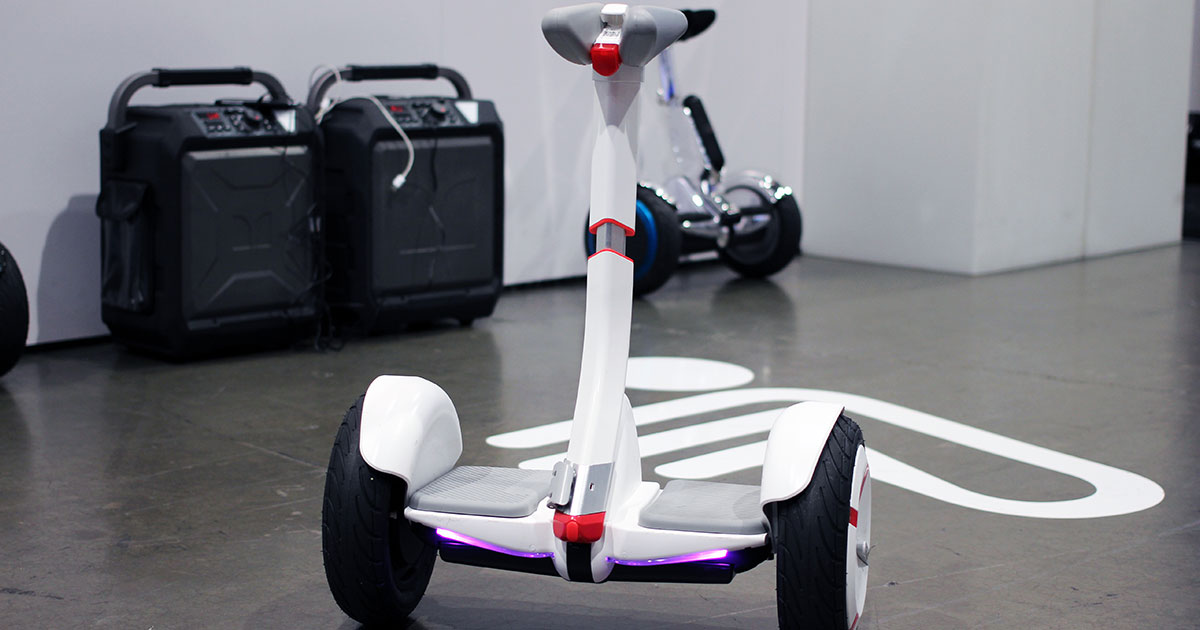Segway: A transportation revolution that lost its way
By Aniket Gupta | 09 Nov 2023

Around 50 years ago, during the 1970s, it was a work of imagination to have a mode of powered transportation that had only two wheels. Oh, I don’t mean a regular conventional scooters, mopeds, or motorcycles. Those types of two-wheelers have an interesting history too, but they are not the topic of this article.
The vehicle I am referring to has two wheels, but they are parallel to each other—not front-to-back as you would expect with a two-wheeler. I am referring to the Segway.
The Segway is a motorized personal vehicle featuring a pair of wheels arranged in parallel on either side of a very short platform on which the rider stands, gripping handlebars for control. The vehicle's movement is determined by how the rider shifts their weight.
The Segway was launched with great expectations of completely changing the landscape of transportation as we know it. Alas, that was not to happen. Today, Segway has just become a toy or a mode of transport used by mall security. The popular film series Paul Blart: Mall Cop features the main character, a mall security guard, riding a Segway to catch the bad guys.
Segway, or Segway Human Transporter (HT), which later came to be known as the Segway Personal Transporter (PT), was launched on 3 December 2001. This two-wheeled, self-balancing electric vehicle seemed like something straight out of a science fiction novel, and it got significant attention.
At the time, Steve Jobs, founder of Apple, famously said that the Segway was going to be ‘bigger than the internet’. But unfortunately, Mr. Jobs, considered to be a visionary himself, could not foresee how much of a failure this product would become (he passed away in October 2011).
The birth of the Segway

The Segway PT was invented by Dean Kamen, an American engineer and entrepreneur. Kamen had previously invented some path-breaking devices used in the medical field. While he was in college in the 1970s, he invented a small infusion pump that allowed drugs to be administered to patients in steady, reliable doses. He named this invention AutoSyringe. He built a company around AutoSyringe, which he sold in his early 30s for millions of dollars.
Kamen then took that money and used it to start a research and development company that would go on to invent more impactful medical devices. Some of those would include a portable dialysis machine that was much smaller than the existing ones, and a flexible heart stent.
In 1990, an encounter left a lasting impression on Dean Kamen. He saw someone in a wheelchair struggling to get over a curb along the side of the road. This experience sparked the inception of his innovative creation, the iBOT, an advanced robotic wheelchair.
This remarkable device was equipped with six wheels, and a powerful motor. The wheelchair had the capability to go up and down roadside curbs and stairs. It could even stand up so the user could match the same height as someone else. During the development of the iBOT, Kamen’s team recognized that the technologies they were creating, including gyroscope balancing and other innovations, could be repurposed to forge an entirely new vehicle, which would later evolve into the Segway.
Segway was initially promoted as a groundbreaking solution to urban transportation challenges. It was marketed as an environmentally friendly alternative to cars, motorcycles, and bicycles, promising to reduce congestion and make commuting more efficient.

The Segway HT, or Segway PT, was designed to be a self-balancing, electric-powered personal transporter. It used a combination of gyroscopes and tilt sensors to maintain balance, allowing riders to effortlessly control their movement by simply leaning in the desired direction.
The initial Segway PT models were equipped with three speed settings: 9.7 kilometers per hour (6 miles per hour), 13 kilometer per hour (8 miles per hour) with enhanced controls for quicker turning, and 16 kilometer per hour (10 miles per hour).
Steering in the early versions was managed through a twist grip that adjusted the speed of the two motors. These p-Series models could travel a distance of 9.7 to 16.1 kilometers (6 to 10 miles) on a fully charged nickel metal hydride (NiMH) battery, and the recharge time typically ranged from 4 to 6 hours.
In September 2003, a recall was initiated for the Segway PT due to a safety concern. It was discovered that if users ignored repeated low battery warnings on the PTs, it could potentially result in a loss of balance and a fall.
In August 2006, Segway Inc., the company created by Dean Kamen to manufacture and sell Segway, stopped making their old models and introduced new products called the i2 and x2. These new products could be controlled by leaning the handlebars to the right or left. They could go up to 20 kilometer per hour (12.5 mph) and had a range of 25–40 km (15–25 miles), depending on the terrain and how you rode them. It took 8–10 hours to recharge them.
The i2 and x2 also had a wireless InfoKey that showed how far you've traveled and could put the vehicle in security mode to prevent theft. You could also switch on the Segway from up to 15 feet away.
If someone looks at a Segway for the first time, he or she will have concerns regarding the movement and balance of the Segway. These concerns however did not curb the hype before its launch. Several media outlets speculated about its potential impact on urban transportation. Segway also had some high-profile supporters, including former US President George W. Bush, who famously took a tumble off a Segway during a test ride. Despite this incident, the device still attracted interest and investment.
Why the Segway failed in the market
There were several reasons behind the failure of the Segway. The first, and one of the biggest reasons, was the launch and the hype before and during the launch itself.
Dean Kamen is a respected inventor who has made several useful inventions in the medical field. Kamen spoke very highly of the Segway, and not only him but many popular personalities from the technology business were hyping up the Segway. We have already seen what Steve Jobs felt about the Segway, but did you know that Jeff Bezos, founder of Amazon.com, called the Segway one of the most famous and anticipated products of all time?
Even famous tech investor John Doerr, who had made significant investments in huge companies such as Amazon and Google, was one of the first investors in Segway. He even went further by stating that Segway would achieve one billion dollars in sales faster than any other product in history.
The general public was hearing much high praise for a product before they knew exactly what it was. These factors started to create unrealistic expectations in people’s minds. Unfortunately, when Segway was launched, it did not live up to these expectations.
The next reason for the failure of Segway was its marketing strategy.
Before the invention of the Segway, Kamen had created many other products. But he never undertook advertising and sales of his own products; these were not his forte. So, for example, the iBOT wheelchair was invented by Kamen’s company but sold by Johnson & Johnson.
But for the Segway, Kamen created a separate company to handle the manufacturing and sale of the product. This was not a good decision, as an experienced sales team would have done things a lot differently than what Kamen did during the launch.
Steve Jobs was one of the few people invited to see the product before it was launched, and he had some pointers. The first bit of advice was to launch the product with just one model and to keep things simple and straightforward for the customers.
Instead, Kamen chose to launch it with two models. Jobs even recommended Kamen’s team make some design changes to the Segway, as it looked very traditional. However, this advice was also ignored.
During the launch, police departments, the post office, and Disneyland were all allowed to test the vehicles. Kamen hoped that they would place big orders; but that did not happen. Meanwhile, an average customer was not able to buy a Segway until almost a full year after that announcement, by which point a lot of the hype around Segway had cooled off.
Another reason behind the failure is that, in most situations, the Segway is simply impractical. It's not even legal in many places to ride it on the sidewalk. Segway Inc. was spending a lot of money lobbying to get these laws changed in various states and cities, but it met with resistance from social groups claiming that it's a safety concern.
Aside from struggling to find a place to ride it, the machine itself was impractical. It was heavy; it could only travel about 20–40 km (15–25 miles) before having to be charged again. It took both hands to ride it, meaning it was hard to do anything else at the same time. These types of issues do not exist on a simple bicycle.
Another major issue with a Segway was its price. Why would an average consumer want to spend on a Segway rather than buying a simple bicycle?
Even some of the top executives in Segway Inc. felt that the product was overpriced. It turns out that the battery that was required, the way it was engineered, and the fact that they manufactured it in New Hampshire, USA, instead of somewhere cheaper overseas, made it so expensive to make that it was difficult to turn a profit if the company sold it any cheaper.
Before the launch, Segway had a $650-million valuation, but Dean Kamen was only willing to sell about 15% of the company when raising capital; so there was always a financial struggle happening behind the scenes.
In December 2009, a British businessman named James ‘Jimi’ Heselden bought Segway Inc. from Dean Kamen. Sadly, a year later, Heselden passed away while riding a rugged country version of the Segway PT when he fell into the River Wharfe.

Segway was sold in 2013, then again in 2015, to a competing Chinese company called Ninebot, which seemingly just wanted it for the hundreds of patents it held so Ninebot could enter US markets with ease. In 2020, Ninebot announced that it would end production of the Segway device in favor of making other products it felt were more cost-efficient and less outdated.
Throughout the product's existence, just 140,000 units were sold, and in later years, the Segway PT accounted for just 1.5% of the company's overall earnings.



















